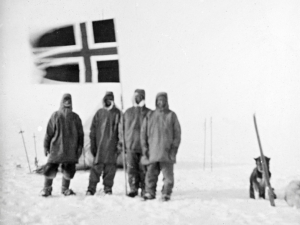Did you know that Olav Bjaaland was one of the best skiers in the country?
Olav Olavsen Bjaaland (1873–1961) was born in Morgedal in Telemark – the cradle of ski sport – and was one of Norway’s best skiers. In 1902 he won the King’s Cup in Holmenkollen.
 Wisting, Bjaaland, Hassel, and Amundsen have reached the South Pole, 14 December 1911. This picture was taken by the fifth member of the team, Helmer Hanssen. Photo: Norwegian National Library.
Wisting, Bjaaland, Hassel, and Amundsen have reached the South Pole, 14 December 1911. This picture was taken by the fifth member of the team, Helmer Hanssen. Photo: Norwegian National Library.
In 1909 Bjaaland competed in a winter sports event in France. On his way to Chamonix he was introduced to Roald Amundsen, who was in the area to prepare for some scientific aspects of his new polar expedition. Amundsen was deeply impressed by Bjaaland's self made skis and equipment. Bjaaland mentioned that it might be fun to be a polar explorer and Amundsen responded that Bjaaland would be welcome to accompany him to the North Pole. It later turned out that they went south instead.
Upon arrival in Bay of Whales in Antarctica, Bjaaland put up the pre-fabricated Framheim hut together with the carpenter of the expedition, Jørgen Stubberud. Throughout the winter the two men contructed and modified sleds, skis and other equipment. On the attempt to reach the South Pole, Bjaaland was sent out on a reconnaissance mission to pick out a safe path over the risky terrain Amundsen later called Satan’s Glacier (now The Devil’s Dancefloor).
After nearly two months on skis and dogsleds, Amundsen and his four men had made their way from the coast of Antarctica to the South Pole, about 2800 metres above sea level. Unbeknownst to the others Bjaaland had brought along cigars and when they had raised the flag at the geographical pole, and he handed out the cigars, causing much joy. The five men stayed at the Pole for four days, in part to immortalise the event in photographs. Amundsen’s camera was not working properly, and Bjaaland stepped in with his own little camera. Bjaaland does not appear on the famous image from the South Pole – the one with the four polar travellers standing outside the tent – simply because he was the photographer.
Bjaaland was described as a quick learner, adaptable, and with a great flair for improvisation. He was also “as strong as a bear” and had a cheerful disposition, characteristics that prompted Amundsen to ask Bjaaland to come along on his next venture, an expedition to the North Pole. Bjaaland declined. After the expedition to the South Pole, he founded a ski factory, with Amundsen’s support, and ran it for many years before retiring to his country home Djuve. During the Olympic Games of 1952 Bjaaland was accorded the honour of lighting the first torch in the relay from Morgedal to Bislett.